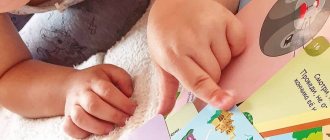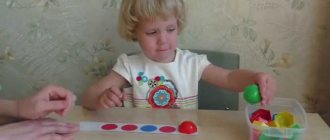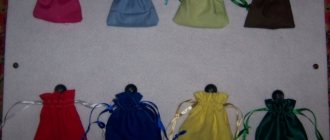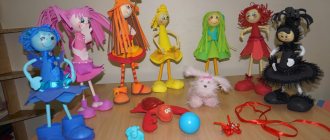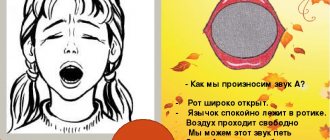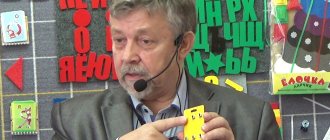What skills do older preschoolers need to develop?
5-6 year old children are very inquisitive. Reading fairy tales and stories with adults, learning to read, count and draw perfectly stimulates interest in understanding the world around us.
The main areas of study during this period:
- fine motor skills training;
- development of attention;
- development of logic;
- speech development;
- numeracy skills.
In this regard, it is possible to divide developmental activities for older preschoolers into the above groups.
Classes for children are conducted in the form of games.
Educational games for children 5 – 6 years old by goal groups
| Target | Game name |
| Fine motor skills training | 1. Stringing |
| 2. Coloring | |
| 3. Origami | |
| 4. Shadow theater | |
| 5. Sort out the cereal | |
| Development of attention | 1. What has changed? |
| 2. What to do? | |
| 3. Claps | |
| 4 Elements | |
| 5. Guess the toy | |
| Development of logical thinking | 1. Drawings from geometric shapes |
| 2. Endings | |
| 3. Fill in the circle | |
| 4. Good - bad | |
| 5. What happens? | |
| Speech development | 1. Complete the sentence |
| 2. Daily routine | |
| 3. Who eats this? | |
| 4. 3 words | |
| 5. What was what? | |
| Numeracy skills | 1. Where is the ball? |
| 2. Forward and backward counting | |
| 3. Feed the animal | |
| 4. Measurements | |
| 5. Cards with numbers |
Games to develop fine motor skills
Since the initial development of relevant skills has already been established at this age, the following games will help further improve fine motor skills in older preschoolers:
- Stringing. You can string beads, rings, buttons, pasta and other items. You will also need fishing line or strong thread. You can hold a “fair” where beads, bracelets and other jewelry made by the children will be presented.
- Coloring. The game is held in the form of a coloring master class or competition. Children are given pictures with outlines of shapes and explained how to hatch. Pictures need to be painted in straight and diagonal directions.
- Origami. Children are given paper and explained how to fold the figures. Then you can offer to organize a competition or play paper toy store.
- Shadow play. Turn off the lights in the room and point the light source at the screen (from a distance of approximately 4 m). Children are shown how to use hand movements between a light source and a screen to create pictures on the screen. You can act out scenes with shadow characters.
- We sort through the cereal. For this game you need to mix 2 types of cereals (for example, buckwheat and rice or millet) and ask the child to help sort the cereal into their jars. Subsequently, the task can be complicated by adding 1 or 2 more types of cereals.
Experts believe that the development of fine motor skills is directly related to the development of speech and intelligence in general.
E. O. Komarovsky
Pediatrician, Ph.D.
Working with your fingers affects the speech areas of the brain. It is necessary to begin developing fine motor skills from six months to 6 years. As a result, speech is formed correctly, memory and imagination are stimulated.
— E. O. Komarovsky Pediatrician, Ph.D.
Games to develop attention
The following games will help your child learn to acquire, accumulate and apply new knowledge:
- What changed? Up to 7 (but not less than 3) different toys are placed in front of the child. At a signal, the child closes his eyes, and the adult removes one of the toys. Then, again at a signal, the child must open his eyes and guess which toy is missing.
- What to do? Before the game starts, children are explained what action to perform when naming a particular word. Then the children walk in a circle, and the leader calls out any of the previously discussed words. In this case, players must perform a certain action (for example, “stork” - stand on one leg, “crawfish” - walk backwards, “hare” - jump, etc.).
- Claps. This is a game similar to the previous one. Only instead of a word, children must perform a certain action for a pre-agreed number of claps. So, for example, 1 clap can mean “stork”, 2 – “crayfish”, 3 – “hare”, etc.).
- Elements. Children sit in a circle. When the leader names a certain element, they must perform a pre-agreed action (for example, “water” - lower your arms, “fire” - raise, “air” - spread your arms to the sides, “earth” - cross your chest).
- Guess the toy. The child needs to depict some actions that would characterize the proposed toys (for example, show how a bear, a fox, etc. behaves).
Julia
In pedagogical activity, one of the main directions is the development of attention, since the quality of teaching will depend on it in the future.
- Julia
Games to develop logical thinking
Logical thinking skills are necessary as preparation for further education. The following games will help develop the ability to think logically:
- Drawing of geometric shapes. Children are given various geometric shapes drawn on a piece of paper. The guys must draw an object or character from the resulting geometric figure (for example, an apple from a ball, etc.).
- Endings. Children are asked to complete sentences like: “Masha left the house before Vera, which means Vera is ... (later Masha).”
- Fill in the circle. Children are given sheets of paper with 6 circles drawn several times and are asked to paint them in such a way that there are as many filled circles as unfilled ones. The one who offers the most shading options will win.
- Good bad. The child is asked to analyze any phenomenon from all sides, paying attention to positive and negative aspects, for example: “A lot of mosquitoes are bad, they bite, but it’s good that the birds have something to eat. There are no mosquitoes - it’s good, but the bad thing is that the birds have nothing to eat, they will fly to other places and there will be a lot of mosquitoes.”
- What happens? Children are encouraged to ask each other questions and take turns answering, for example: “What is white? (cloud, towel, etc.)” “What is big? (joy, car, mountain, etc.).”
Elena
Orenburg
A child’s logical thinking needs to be developed systematically and in a timely manner, so that in the future he can study well and achieve his goals.
— Elena Orenburg
Speech development games
Speech development is an important stage of learning; the following games will help with this, by the way, closely related to the previous group of logic lessons:
- End of sentence. Children are asked to complete the sentences based on the context (Vita didn’t come today because ... (sick); dad brought ice cream and put ... (in the refrigerator); Marina is going to the store to ... (buy groceries)).
- Daily regime. Children are shown pictures of different activities during the day. The children are asked to place them in the correct order.
- Who eats this? Pictures depicting various animals are given, and it is asked to determine which of them should be given, for example, grain, honey, apples, grass, etc.
- 3 words. Children are asked to name 3 words as an answer to one question, for example: “What can you cook? (egg, meat, pasta).”
- What was what? The presenter asks questions like: “Who used to be a chicken, a butterfly, a horse?”, “What used to be bread, a sweater, a table?”, and the children need to answer them.
A. N. Leontiev
Soviet psychologist, author of the general psychological theory of activity
Speech occupies a central place in mental development, the process of its development is development itself.
— A. N. Leontyev Soviet psychologist, author of the general psychological theory of activity
Logic problems in mathematics senior group
Mathematics problems for senior group. Logic problems.
1. Sasha ate a large and sour apple. Kolya is big and sweet. What is the same and what is different in apples? 2. Masha and Nina looked at the pictures. One in a magazine, the other in a book. Where did Nina look if Masha didn’t look in the magazine?
3. Tolya and Igor were drawing. One is a house, the other is a branch with leaves. What did Tolya draw if Igor did not draw the house?
4. Alik, Vanya and Vova lived in different houses. Two houses had 3 floors, one had 2 floors. Alik and Borya lived in different houses, Borya and Vova also lived in different houses. Who lived where?
5. Kolya, Vanya and Seryozha were reading books. One is about travel, another is about war, the third is about sports. Who read about what, if Kolya didn’t read about war and sports, and Vanya didn’t read about sports?
6. Zina, Lisa and Larisa were embroidering. One is leaves, the other is birds, the third is flowers. Who embroidered what if Liza didn’t embroider leaves and birds, and Zina didn’t embroider leaves?
7. The boys Slava, Dima, Petya and Zhenya planted fruit trees. One is apple trees, the second is pears, the third is plums, the fourth is cherries. Who planted what if Dima is not plum trees, apple trees and pears, Petya is not pears and apple trees, and Slava is not apples?
8. Two girls planted trees, and one - flowers. What did Tanya plant if Sveta and Larisa and Marina and Tanya planted different plants?
9. Three girls drew two cats and a hare. What did Asya draw if Katya and Asya and Lena and Asya drew different things?
10. Two boys bought stamps, one bought a badge and one bought a postcard. What did Kolya buy if Zhenya and Tolya and Tolya and Yura bought different things, and Misha bought a badge?
11. Two boys lived on one street, and two on another. Where did Petya and Kolya live, if Oleg and Petya and Andrey and Petya lived on different streets?
Serious challenges
1. Kolya sculpted 4 soldiers, and Slava - 1. How many soldiers did the guys sculpt in total?
2. There were 6 porcini mushrooms and 3 boletus mushrooms in the basket. How many mushrooms were there in total?
3. There were 6 mushrooms in the basket, 1 mushroom turned out to be inedible and was thrown away. How many mushrooms are left?
4. 5 roses bloomed on the bush. Mom cut 3 pieces, how many are left?
5. There were 3 roses in the vase. Mom cut 2 more. How many roses were in the vase?
6. There were 5 red cups and 1 blue cup on the shelf. How many cups were there?
7. There are 8 tomatoes ripe on the bush. Four tomatoes were picked. How much is left?
Comparison problems.
1. Galya is more fun than Olya, and Olya is more fun than Ira. Who's the funniest?
2. Inna’s hair is darker than Olya’s. Olya's is darker than Anya's. Who has the lightest hair?
3. Tolya is taller than Igor, Igor is taller than Kolya. Who is tallest?
4. Katya is faster than Ira, Ira is faster than Lena. Who is the fastest?
5. Sasha is sadder than Tolya, Tolya is sadder than Vanya. Who's the most fun?
6. Misha is stronger than Oleg, Misha is weaker than Petya. Who is the strongest?
7. The hare is weaker than the dragonfly. The hare is stronger than the bear. Who is the weakest?
8. Sasha is 10 years younger than Igor. Igor is 2 years older than Lesha. Who is the youngest?
9. Ira is 3 cm shorter than Klava. Klava is 12 cm taller than Lyuba. Who is tallest?
10. Tolik is much lighter than Seryozha. Tolik is a little heavier than Valera. Who is the lightest?
11. Vera is a little darker than Luda. Vera is much brighter than Katya. Who is the brightest?
